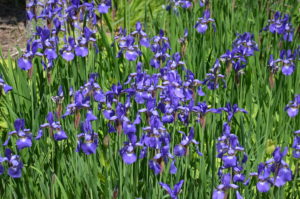Siberian iris (called beadless iris) are favorites of gardeners and landscapers. Why? – ease of maintenance, plant longevity, and trouble free. Their flowers are smaller than the bearded iris blooms, but their grass-like foliage stays attractive all season long. They are more cold hardier.
Siberian irises are mostly hybrids of two southwest Asian species, I. sibirica and I. sanguinea (USDA hardiness zones 3-9). The narrow, grass-like foliage forms a vase-shaped clump to 2 feet high. Autumn foliage turns rusty brown in late fall. Flowering stems rise above the foliage to 3 feet height in May-June.
Siberians perform well in most garden soils, but perform best in a humus-rich, mildly acidic soil. In spring feed with 10-10-10 or equivalent granular fertilizer. In early summer apply a booster feeding using a water soluble product such as Miracle-Gro™, Jack’s™, or Espoma™. Mulch iris in spring to conserve soil moisture and prevent weed infestation. Remove spent bloom stalks, and brown and withered leaves to keep planting looking attractive. In late fall cut back all leaves 1-2 inches above the ground.
In Northern states (zones 3-6), Siberians perform best in full day sun (or 6-hours minimum). In Southern areas, shelter from the mid-day sun.
Cultivars: Over 200 varieties are available, principally from online iris nurseries. (American Iris Society descriptions)
‘Butter and Sugar’ – white standards, yellow falls, 28 inches tall.
‘Caesar’s Brother’ – dark purple flowers, 36 inches.
‘Dreaming Yellow’ – cream standards, pale yellow falls, 30 inches.
‘Humors of Whiskey’ -pink-white standards and golden brown falls, 29 inches.
‘King of Kings’ – crisp white self with yellow shading in center; 33 inches tall.
‘Miss Apple’ – two-toned red flowers with yellow highlights, 30 inches tall
Siberian irises are generally pest-free, with very little susceptibility to the two main problems of bearded iris, namely iris borer and bacterial soft rot. Voles and mice may munch on rhizomes. Plants tolerate deer and rabbits.
Divide big healthy clumps into 2-4 fans in late summer or fall, depending where you live. In southern climes, early fall is a better time. Clumps can grow undisturbed for several years, unless they become crowded, plant vigor declines, or bloom size falls off.



 Posted in
Posted in 
